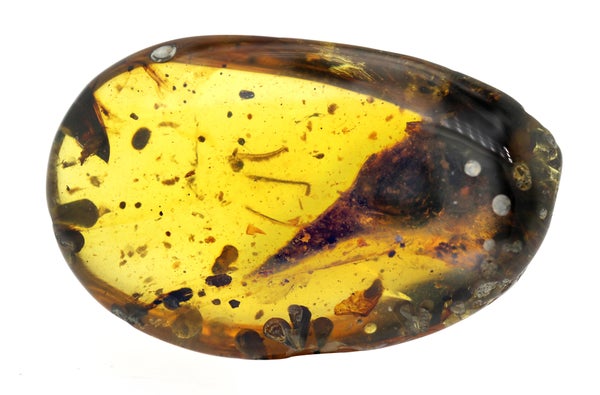Smallest Known Dinosaur Found in Amber (original) (raw)
A bird skull from Myanmar hints at a lost world of tiny fossils that are waiting to be unearthed

Amber with Oculudentavis skull from Myanmar. The skull is 99 million years old and nearly perfectly preserved.
Editor’s Note (7/22/20): The study this story was based on has been retracted because a new unpublished specimen casts doubts on the researchers’ hypothesis regarding the phylogenetic position of the fossil they described.
The word “dinosaurs” conjures up images of fierce and enormous reptiles. But not all of the “terrible lizards” were huge. Part of their success rested on the fact that they came in all shapes and sizes. And now paleontologists have revealed what may be the smallest dinosaur of all time.
Described by China University of Geosciences paleontologist Lida Xing and his colleagues in a study published Wednesday in Nature , the 99-million-year-old fossil was found in Myanmar and is part of a growing number of amber-bound windows into the Mesozoic world. Paleontologists working in the Southeast Asian country have in recent years encountered dinosaur tails, baby birds, new insect species and even seagoing creatures that became enclosed in gobs of sticky sap. What makes this latest find stand out, however, is just how tiny it is.
On supporting science journalism
If you're enjoying this article, consider supporting our award-winning journalism by subscribing. By purchasing a subscription you are helping to ensure the future of impactful stories about the discoveries and ideas shaping our world today.
The newly discovered dinosaur, preserved within hardened resin during the Mid-Cretaceous period of the Mesozoic era, is represented by nothing more than a skull. From its tiny teeth to the delicate ringed bones of its eyes, it only measures about half an inch long. But even though amber-encased fossils are sometimes difficult to study—given that researchers must rely on imaging techniques to slice through the layers of resin—it is apparent that this little creature was a toothed bird that lived during the reign of its dinosaurian kin. Xing and his co-authors have named it _Oculudentavis khaungraae_—with the genus being derived from “toothed eye bird” in Latin and the species being designated in honor of fossil collector Khaung Ra, who donated the item for study.
Artistic rendering of Oculudentavis that imagines what it looked like while preying on an insect. Credit: Han Zhixin
Precisely where Oculudentavis belongs on the bird family tree is not quite clear. It appears to be a relatively archaic form that paleontologists call a stem bird—a bird close to the point at which avians split from their feathered dinosaur ancestors. Then again, additional analyses or fossil finds might change which branch it is placed on. Although Oculudentavis really does seem to be a bird, says Bruce Museum paleontologist Daniel Ksepka, “I would be unsurprised if it turned out to fall somewhere else in the bird part of the dinosaur family tree.” (Ksepka was not involved in the new paper.)
What most excited study co-author Lars Schmitz, a paleontologist at Claremont McKenna, Scripps and Pitzer colleges, were the tiny animal’s eyes. “I must say the scleral ring of Oculudentavis is just great,” Schmitz says, noting that the thin, delicate bones of each eye are in place and only slightly deformed through fossilization. The arrangement of these bones can say something about when Oculudentavis was active. “The individual bones of the ring have an odd lizardlike shape. And the proportional size of the opening where the pupil would have been suggests daytime activity,” Schmitz says.
In life, Oculudentavis would have been about the size of a small hummingbird. This stature makes it the tiniest Mesozoic dinosaur yet discovered, significantly smaller than other contenders for the title, such as Fruitadens in Colorado. And identifying small species has a big influence on how paleontologists reconstruct the past.
Large dinosaurs were some of the first to be discovered and attain fame. Not only did such species have sturdy bones capable of withstanding the violence of decay and preservation, but (during the early 20th century in particular) museums and paleontologists intentionally looked for big, imposing animals that would help build careers and drive exhibit attendance. Scientific infatuation with larger dinosaurs was so great that informative and important skeletons were sometimes “headhunted,” because collecting impressive skulls was seen as more critical for building collections. But miniature species were historically ignored by fossil hunters, meaning that there are undoubtedly small species waiting to be found.
Along with discoveries in other localities—such as the fossil beds of Liaoning province in China, which have yielded dozens of exquisite specimens—Oculudentavis and additional finds in Myanmar’s amber have started to put together a view of the dinosaurian world that differs from what has been assembled from classic spots in the American west. And the new find is relevant to the range of sizes birds took through time. “I was amazed by how small this fossil was,” Ksepka says. A better body fossil is needed, to be sure, but Oculudentavis might be smaller than even the tiniest modern hummingbirds. If that possibility turns out to be the case, Ksepka notes, it would mean the largest and smallest birds of all time are extinct.
More finds like Oculudentavis will probably follow it. “We are currently only capturing a small fraction of the small end of the size spectrum, with an incomplete picture of the biodiversity in the age of dinosaurs,” Schmitz says. Even in relatively familiar fossil-producing spots, the most likely candidates for new species are going to be comparatively tiny. These animals are just as important as the hulking mountains of bone that fill museum halls. They are the threads that helped form the ecosystems beneath the feet of giants.
.jpeg?w=900)